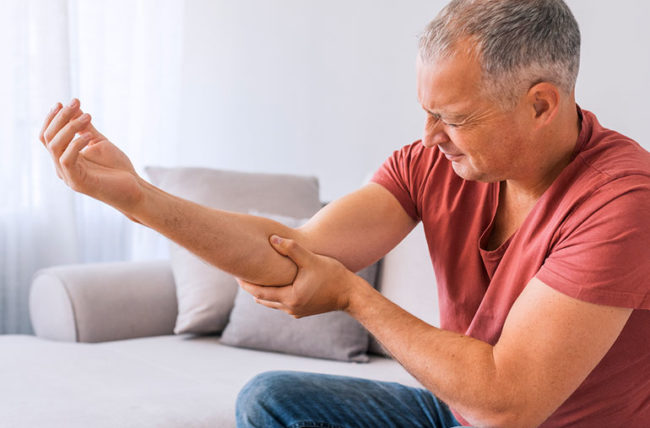
You might not think much about the state of your elbows until you begin to feel some pain or discomfort. The elbow is the area where the radius and ulna (forearm bones) meet with the humerus (bone in the upper arm). Ligaments, muscles, and tendons help with bending or straightening the elbows. Elbow pain can result from an acute injury or chronic disease, and can significantly impact your overall quality of life. If you’re facing persistent elbow pain, you should see Dr. Daniel Brereton in La Jolla for an evaluation and treatment.
What Can Cause Elbow Pain?
Most times, elbow pain results from the strain or inflammation of soft tissues, like tendons and ligaments. The strain or inflammation tends to improve after several days with simple home care.
However, at times, a medical condition may cause elbow pain. An example is arthritis, which is characterized by a painful and swollen joint. The most common types of arthritis that cause elbow pain are rheumatoid arthritis and osteoarthritis. Other types of medical conditions that can cause elbow pain include bursitis, tendinitis, and ulnar nerve entrapment.
Elbow pain can also be caused by stiffness, because of issues with the joint or with surrounding muscles and ligaments. In certain cases, like after an injury or surgery, soft tissue may become scar tissue, resulting in elbow stiffness.
Sometimes, the elbow might lock into one place due to some loose bone or cartilage in the elbow, and lead to pain. Such fragments may require surgery to wash them out.
When Should You See a Doctor for Elbow Pain?
Most elbow pain cases can be managed at home with rest, applying ice, compressing the joint, or elbow elevation. But, some will require medical intervention. You should consult a medical professional if:
- Your elbow pain persists even after taking pain medication and resting the joint for two weeks
- Your arm or hand exhibits a tingling sensation, numbness or weakness
- You notice symptoms like severe pain that makes arm movement difficult, swelling, fever and redness. Such symptoms can indicate the presence of an infection
- You feel pain and have bruising and swelling, because of a recent injury, like falling onto your outstretched arm
- Pain is existence even if you are not moving your arm
- The elbow pain changes from a slight ache to a sharp pain
- Your pain comes back when you resume an activity like lifting a heavy object
Who to See For Your Elbow Pain
When you visit an emergency room, an emergency doctor will assess your condition. That physician will determine whether an emergency treatment will help or you require the assistance of an orthopedic specialist or surgeon. If your pain is caused by nerve damage, you may be referred to a neurosurgeon.
Many times, primary care doctors provide treatment for most elbow pain that doesn’t require urgent care. However, your physician might give you a referral to another medical professional for more specialized treatment. Specialists who deal with elbow pain include orthopedic surgeons, physical therapists, sports medicine doctors, and rheumatologists.
Elbow pain may disrupt your work and sporting activities; therefore it’s essential to see a doctor if your joint discomfort persists. The earlier you begin treatment for your elbow, the easier it may be to resolve the problem.